It’s Time to Think About Middle-Skill Jobs and Education
The traditional higher-education system works for many, but not everyone desires or can afford a college degree. About one in three US adults age 18 and older hold a high school degree as their highest level of education. While well-paying jobs for workers with a high school diploma alone still exist, they have rapidly declined. By 2020 it is expected that almost two-thirds of all jobs will require some postsecondary training or education.
Is there a solution to this dilemma? Shall we begin to rethink the traditional educational model by focusing in between the two extremes of either “no college” or a full four-year degree? It would be sensible to increase attention towards “Middle-skill” pathways, which can provide gainful employment and encourage further education and degree completion.

Middle-skill pathways are in high demand
Middle-skill pathways—education beyond high school, but less than a bachelor’s degree—can help people achieve success in the labor market by teaching skills that are in high demand. According to the Virginia Employment Commission, as of 2016, there were 2.4 million middle-skill jobs in Virginia, and by 2026 that number is expected to increase by 200,000.
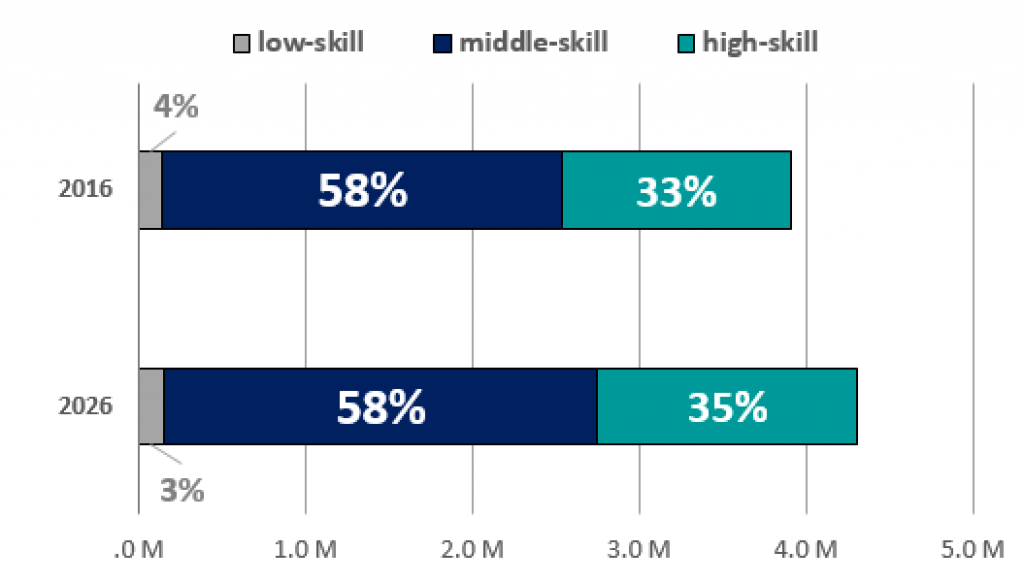
The National middle-skill job tabulations are based on BLS 2016-2026 Employment Projections and Education and Training Requirements. Virginia figures are based on the Virginia Employment Commission (VEC) long-term occupational projections and the CTE career cluster oriented Trailblazers labor market data. Occupation skill type was determined using the predominant level of education as follows:
Predominant level of education is determined by the Weldon Cooper Center as the higher one between (1) the required education for entry-level and (2) the prevalent education level among workers. This may inflate the higher-skill categories to a certain degree. |
While middle-wage jobs have been slow to grow, due to the fact that some of them have moved offshore or been automated, employers are increasingly demanding a higher skill level for the relatively fewer job slots and will pay more for it. Thus those middle-wage jobs have become high-wage jobs, and those that can’t obtain some sort of education post-high school are stuck earning low wages – resulting in job polarization.
Middle-skill occupations are diverse and spread among a wide variety of industries. Human Services and Health Sciences are the top projected growing Career and Technical Education Career Cluster in Virginia moving towards the year 2026 (Figure 2). Information technology closely follows with a projected growth of around 17 percent. Manufacturing and Agriculture are among the lowest projected growth clusters growing 1 and 5 percent respectively – which include trades that may traditionally be associated with middle-skills.
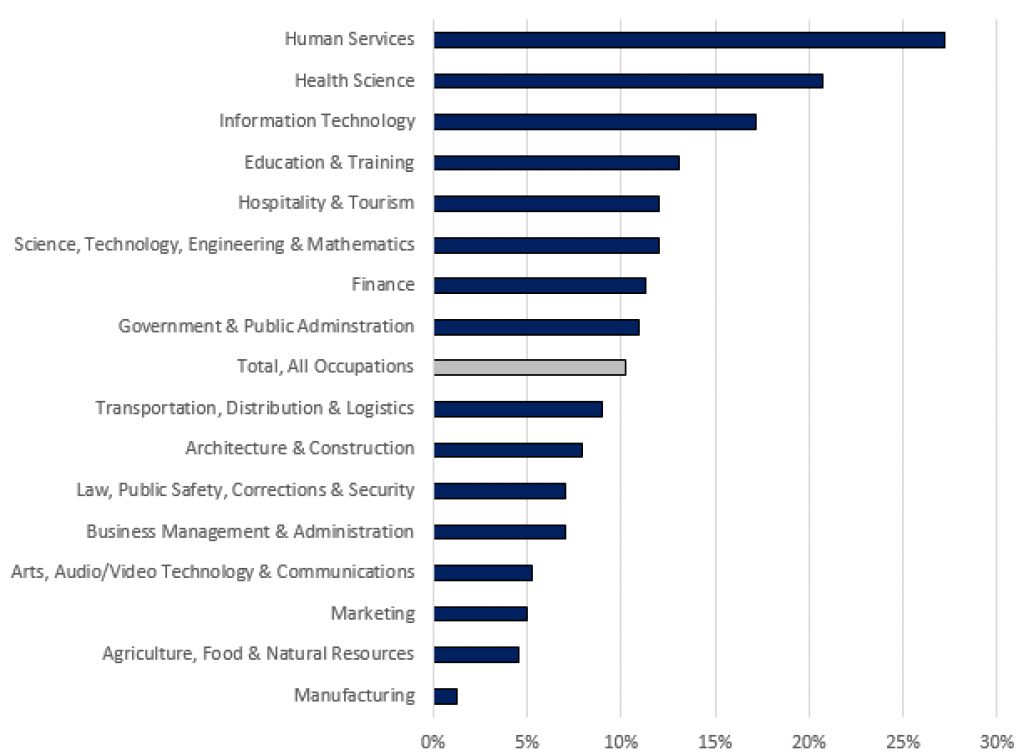
In addition, Figure 3 shows some examples of middle-skill occupations by their CTE Career Cluster. It is important to note that although some of these occupations are growing at a slower pace, none are declining in these examples. Demands for middle-skill labor in key sectors will remain high. Replacement needs will be strong for retiring baby boomers, many of which are employed in middle-skill positions.
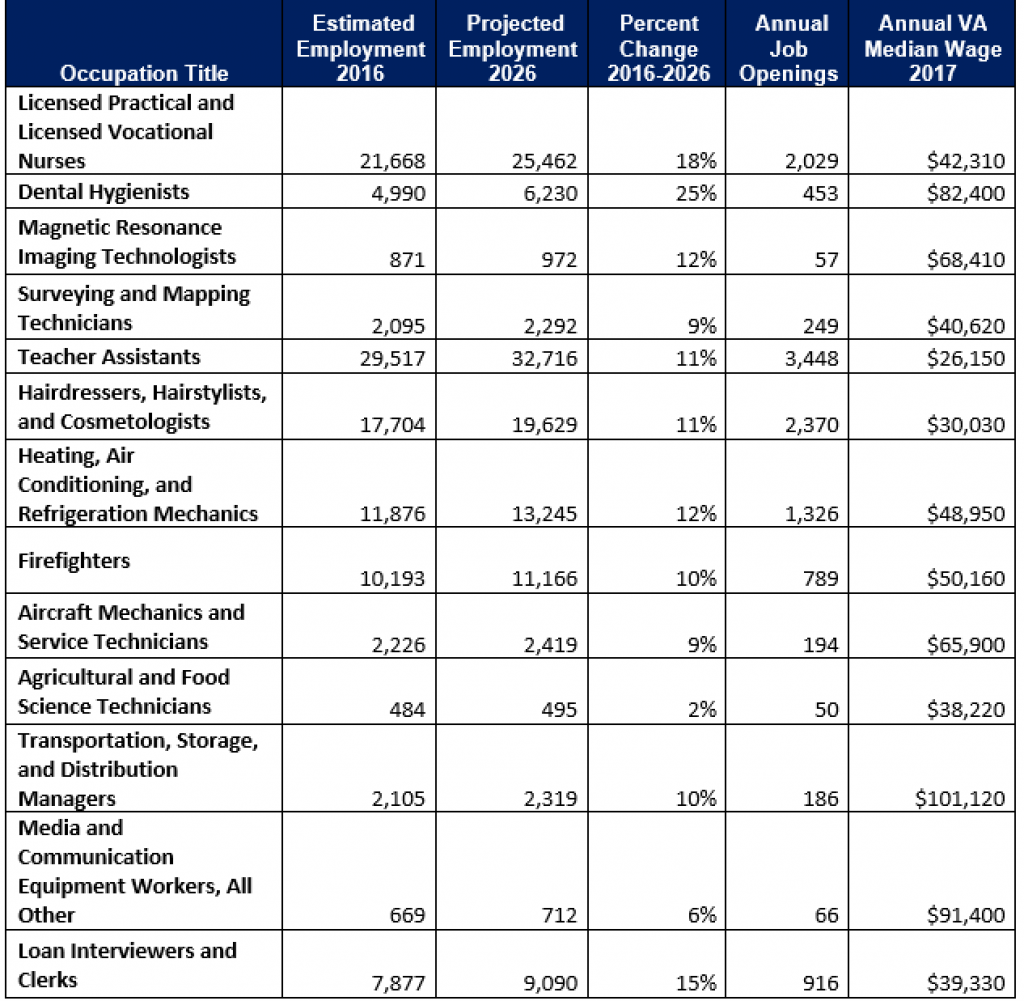
It is worth noting that twenty-two of the top thirty highest projected growth middle-skill occupations are related to the medical field. Of the top 10, all are Health Science related (Figure 4). The aging population and thus demand for their care is a major driver of this demand. By 2025, it is projected that the U.S. will likely face a shortage of almost half a million Home Health Aides, 95,000 Nursing Assistants, and nearly 100,000 Medical and Lab Technologists – all of which are middle-skill.
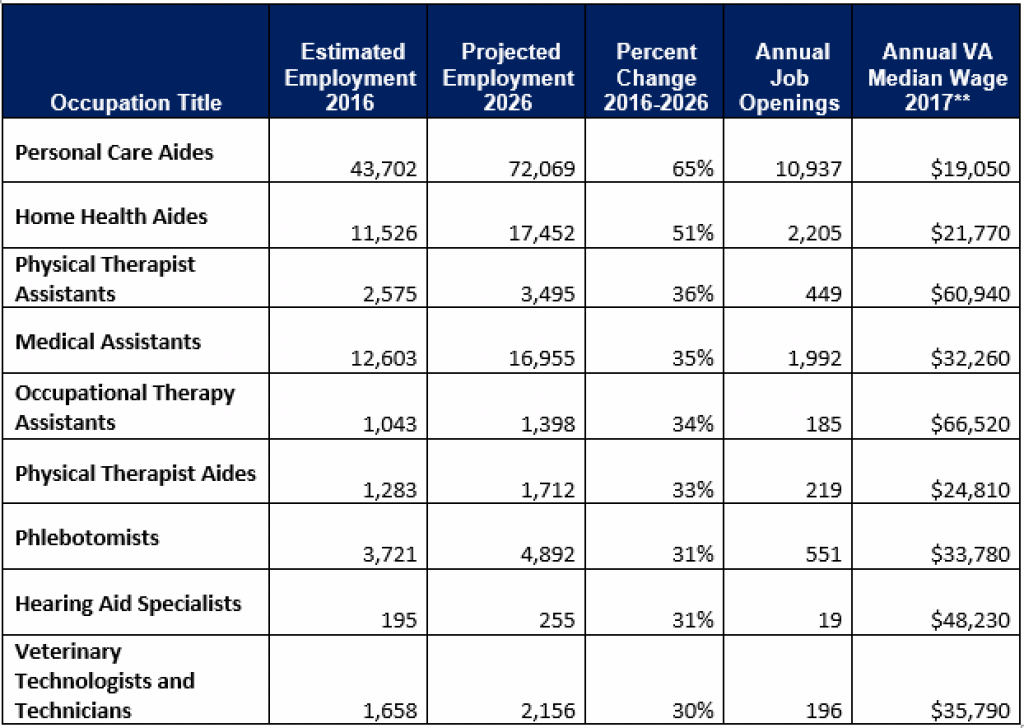
Middle-skill pathways can be high paying
Not only are middle-skill pathways in high demand but they can also be high paying. Many viable career paths do not require a bachelor’s degree: there are 44 million middle-skill jobs that pay more than the national median personal income in the US, 1.1 million of which are in Virginia. Nearly half of all middle-skill jobs in Virginia make more than the national median personal income. It is important to note that many of these jobs may pay higher than the median, and this is especially the case for workers with specialized certification and training.
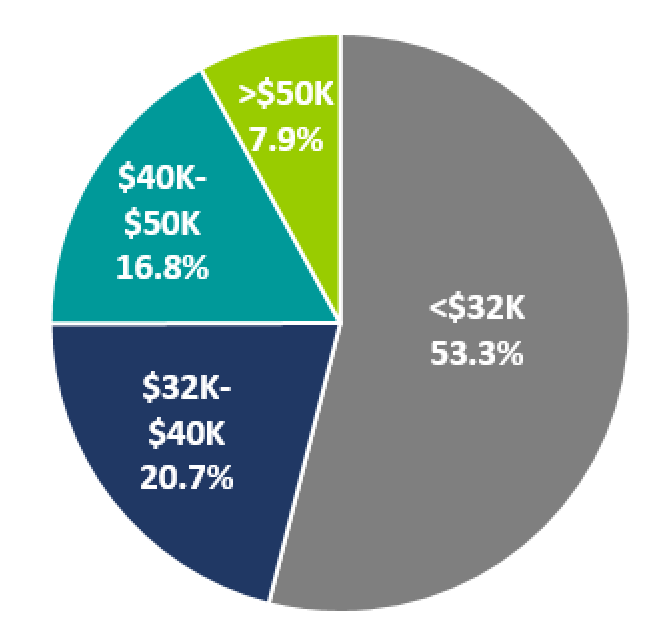
Middle-skill pathways are lacking
The ability of the U.S. Education system to develop midlevel skills is deficient. Education and workforce systems are failing to keep pace with the changing needs of the economy, and employers are struggling to find skilled workers. The demand is there, but obviously, the supply is lacking.
By limiting some of the barriers to a traditional four-year degree, middle-skill pathways are feasible for a larger number of individuals. They typically take less time, offer flexibility in scheduling, are relatively cheap, and can be an effective way for disadvantaged and/or first-time college students gain entry into education that can be immediately useful. This type of education can expand career opportunities without limiting future options. Unemployed and underemployed individuals can use these pathways to jumpstart their education while incumbent workers can re-skill and get ahead in the changing workforce.
For example, a teacher assistant job that previously required only a high school education now might require coursework. Without an accessible middle-skill education pathway, that aspiring teacher’s assistant is forced to choose between obtaining a bachelor’s degree (which may be out of reach) and becoming a full teacher or working a low-wage job at the local coffee shop. A middle-skill education fills this gap, enabling our aspiring teacher’s assistant to step into the role. This is not only good for the individual but good for the overall economy with workforce demands being filled and the school retaining necessary it’s staffing.
Preparing for a middle-skill occupation
Some institutions are responding with both old and new education and training programs in the middle-skill category. Preparation for middle-skill jobs has been traditionally through community college education, associates degrees, apprenticeships, or on-the-job training. Options have expanded to include education at for-profit colleges, certificates, certifications, badges, coding and technology boot camps, course clusters, and career and technical education (CTE) programs that start in high school and extend into community colleges.
The often misunderstood certificate is the fastest-growing form of college credential, according to a Georgetown University Study. Certificates are earned through seat time in a classroom from a college or university and are credit-earning, unlike industry-based certifications which are typically awarded based on tests. A certificate from a college or university often can prepare a student to take an industry-based certification test; however, it can typically be built upon, serving as a stepping stone to a higher degree.
A certificate is the highest form of education held by about 1 in 10 American workers and certificate holders earn 20 percent more than workers who hold only a high school diploma. In 2017, Virginia as a whole awarded just over 20,000 certificates with rates being highest in the rural areas of the state. One-third of certificate holders also have an associate, bachelor’s or graduate degree. Of these workers, two out of every three earned the certificate first, an indication that certificates can serve as a stepping stone on the way to a college degree.
Conclusion
Increasing access to four-year bachelor’s degrees, which are a proven pathway to economic mobility, shall be a continued priority. However, often looked down upon “middle” education pathways can lead to fulfilling and well-paying careers, as well as offer a bridge to higher education. Whether it be through certificates, diploma programs, or Associate’s degrees, they can provide a more accessible alternative towards career success while fulfilling labor market demand. Middle-skill pathways are a cost-effective tool for increasing postsecondary educational attainment and gainful employment.
In a time where traditional college enrollment is expected to decrease, and job market skills rapidly change with innovation, it may be time to rethink our higher education system and invest in other alternatives.


